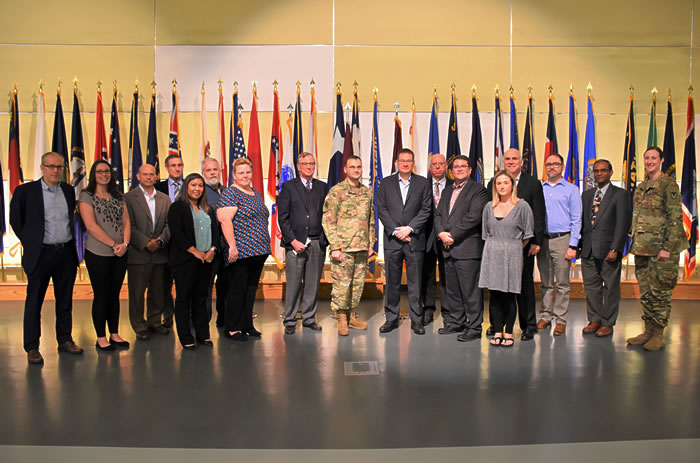USAMMDA Celebrates FDA Approval of Antimalarial Drug Tafenoquine

Members of the U.S. Army Medical Materiel Development Activity's Tafenoquine Integrated Product Team were among those gathered to celebrate the U.S. Food and Drug Administration approval of the antimalarial drug Tafenoquine, during a ceremony held at Fort Detrick, Oct. 25.
From left to right: Ty Miller, Kristina Pannone, Dr. Gregory Reichard, Robert Charles, Jennifer Rebelez, Dr. Francis Klotz, Mary "Kathy" Simpson, Dr. Lawrence Lightner, Maj. Victor Zottig, Dr. Geoff Dow, Dr. William McCarthy, Dr. Bryan Smith, Carmen Sanders, Doug Loock, John Clarke, Dr. Selva Murugesan, and Maj. Katherine Carr. (Photo by Ashley Force, USAMMDA public affairs)
The U.S. Army Medical Materiel Development Activity hosted a large gathering to celebrate the recent U.S. Food and Drug Administration approval of Tafenoquine, the first FDA-approved prophylactic drug for malaria in more than 18 years. Maj. Gen. Barbara R. Holcomb, commanding general of the U.S. Army Medical Research and Materiel Command and Fort Detrick, served as keynote speaker for the event, which took place at the Fort Detrick auditorium, Oct. 25.
Transmitted through the bite of infected mosquitoes, malaria remains the top infectious disease threat to U.S. Service Members deployed overseas. In light of this, the Department of Defense has been committed to discovering an effective solution for the prevention and treatment of the life-threatening illness among its troops. However, because of Tafenoquine's success as a weekly administered prophylactic drug, it will be commercialized outside of the DOD to help protect civilian populations worldwide.
First discovered in 1978 within the Experimental Therapeutics branch at the Walter Reed Army Institute of Research, Tafenoquine has been the focus of extensive research for the past four decades. In 1988, the drug was transitioned to USAMMDA's Pharmaceutical Systems Project Management Office for management and oversight of the product development effort, and it has remained under the PSPMO's guidance since that time.
Over the past 40 years, various organizations have been involved in the study of the drug, and these include the Armed Forces Research Institute of Medical Science in Thailand, the U.S. Army Medical Research Unit – Kenya (now the U.S. Army Medical Research Directorate – Africa), the Naval Medical Research Unit-3 (Egypt/Ghana), the Army Malaria Institute of the Australian Department of Defence, WRAIR, USAMMDA and its industry partner for production of the drug, 60° Pharmaceuticals, LLC.
"Today is a great day, as we celebrate the historic achievement of the FDA approval of Tafenoquine," said Col. Ryan Bailey, USAMMDA commander. "This critical milestone is aimed at stopping the spread of malaria worldwide, and the suffering, and death, caused by this disease."
Col. Deydre Teyhen, WRAIR commander, highlighted her organization's efforts to help determine the best drug candidate to battle malaria, stating "Every FDA-approved malaria prophylaxis drug has come from or through WRAIR's Experimental Therapeutics test systems. Today, we're building on that amazing history to keep pushing the boundaries of malaria treatment and prevention. To make Tafenoquine even better than the breakthrough that it is, our scientists continue to investigate its metabolism, safety profile, and mechanism of action."
Dr. Dennis Shanks, director of the Australian Defence Force Malaria and Infectious Disease Institute, followed Teyhen, and he provided insight regarding the future of the Tafenoquine product.
"This is … a milestone and not the finish line," said Shanks. "Although the military has achieved what it set out to do, there are several important public health indications that remain, such as Tafenoquine's use in children and the elimination of malaria transmission on islands.
"Malaria elimination requires, at a minimum, that we stop the exchange of parasites between Asia and Africa, and Tafenoquine is well-suited for this purpose," he added.
In her keynote address, Holcomb emphasized Tafenoquine's unique place in the history of the USAMRMC's lifecycle management process, as the command has overseen the drug from its early science and technology phase through to the creation and fielding of the product.
"Tafenoquine's journey, which began in 1978, has been in the making for 40 years," said Holcomb. "But it's a relatively short journey compared to Malaria's history, as the deadly bite dates back in early human history to 323 B.C., when Alexander the Great reportedly died from the disease.
"Tafenoquine fulfills an unmet military need by protecting the Warfighter against malaria parasites with a simple and safe regimen — a weekly dosing schedule is all that is required, and the value of this cannot be understated," she continued. "This is all possible today, because 40 years ago, leaders and scientists had a vision to combat malaria."
Addressing all who had a hand in the development of the product, Holcomb said, "Whether you worked on Tafenoquine for a day, a year, or your entire career, your contributions helped gain approval for the first FDA-approved malaria drug in over 18 years. This is not just a military achievement, but a significant achievement for world health."
Under the direction of the U.S. Army Materiel Command, the USAMRMC serves as the Army's medical materiel developer, working to establish and maintain the capabilities needed to fight and win on the battlefield. As a USAMRMC subordinate command, USAMMDA is tasked with a mission to develop and deliver quality medical capabilities to protect, treat and sustain the health of Service Members throughout the world, and it remains focused on the development of successful products and devices that are critical for maintaining the strength and readiness of our nation's military forces.













